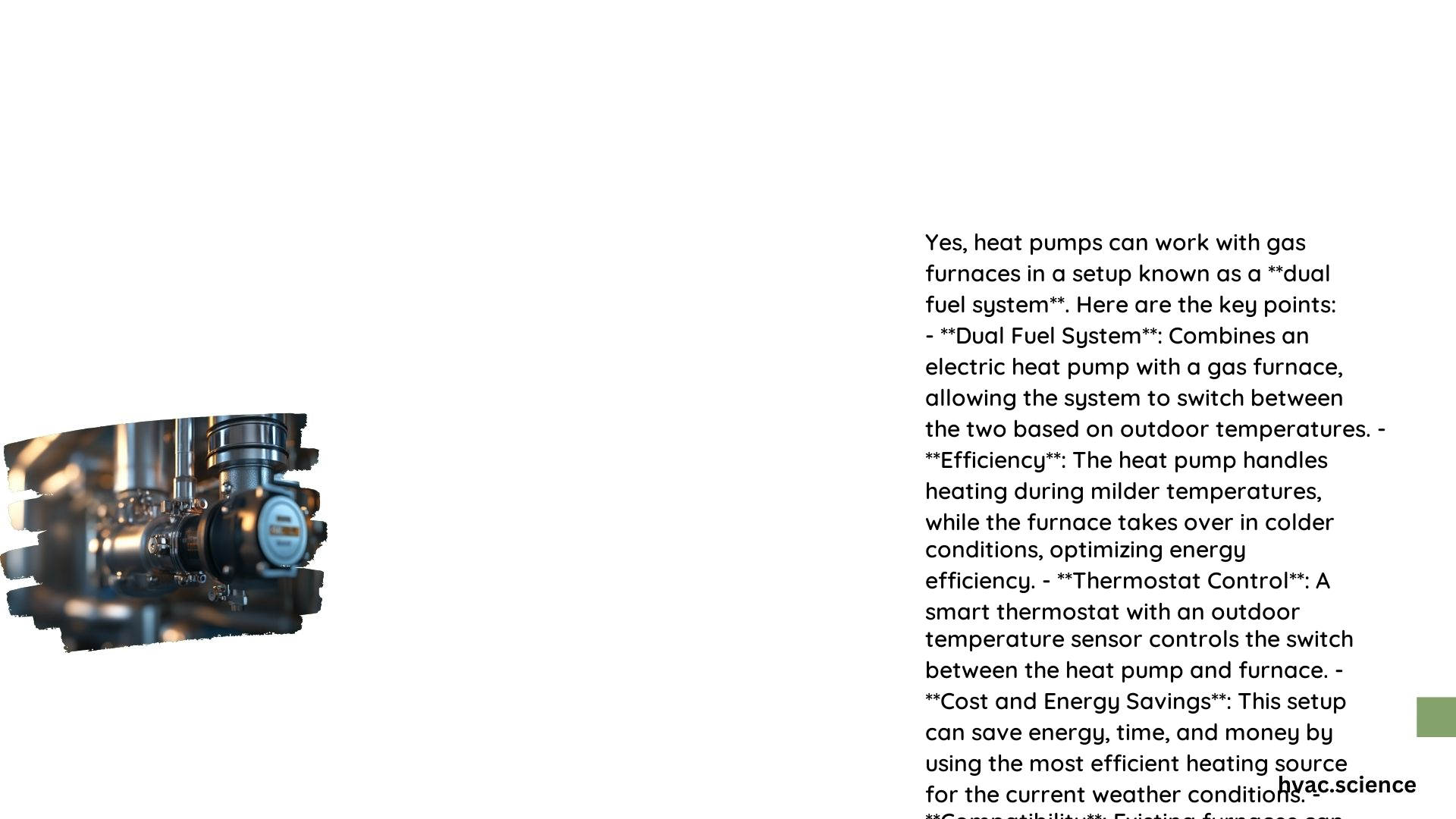A dual fuel system that combines a heat pump with a gas furnace can be an efficient and cost-effective heating solution, especially in colder climates. By leveraging the strengths of both technologies, homeowners can optimize energy usage and maintain consistent indoor comfort.
What is the Comparison of Gas Furnace vs Heat Pump?
Efficiency Ratings
- Gas Furnace: Gas furnaces are generally around 95% efficient, meaning they convert about 95% of the energy they consume into usable heat. However, their efficiency can vary based on the model and age of the furnace.
- Heat Pump: Heat pumps are highly efficient, especially in mild temperatures. They can provide 3 units of heat for every 1 unit of electricity consumed, making them more energy-efficient than gas furnaces in certain conditions. However, their efficiency drops significantly in very cold temperatures.
Operational Costs
- Gas Furnace: The operational cost of a gas furnace depends on the cost of natural gas or propane. In colder climates, gas furnaces can be more cost-effective for heating, especially during extremely cold periods.
- Heat Pump: Heat pumps are generally cheaper to operate in mild temperatures because they use electricity to transfer heat rather than generate it. However, in very cold temperatures, they may require supplemental electric heat strips, which can increase operational costs.
Performance Metrics
- Gas Furnace: Gas furnaces produce hot air quickly and can maintain high temperatures, making them suitable for colder climates. However, they only produce heat and require a separate cooling system.
- Heat Pump: Heat pumps can both heat and cool a home, making them versatile. However, they produce lower duct temperatures compared to gas furnaces, which can feel less warm, especially in cold weather.
How Does the System Integration and Mechanics Work?

Dual Fuel System
A dual fuel system combines a heat pump with a gas furnace. The heat pump operates as the primary heating source in mild temperatures, while the gas furnace takes over during colder periods. This system is controlled by a thermostat that can switch between the heat pump and the furnace based on outdoor temperatures.
Control Strategies
The system uses a smart thermostat with an outdoor temperature sensor to determine when to switch from the heat pump to the gas furnace. This ensures that the most efficient heating method is used based on the current weather conditions.
Necessary Modifications
To integrate a heat pump with an existing gas furnace, you may need to install a new thermostat capable of supporting dual fuel systems. Additionally, the indoor coil may need to be compatible with the new heat pump, and any necessary ductwork modifications should be made.
Is it Feasible to Use a Heat Pump with an Existing Gas Furnace?
Compatibility Considerations
The existing gas furnace and ductwork must be compatible with the new heat pump system. Specifically, the indoor coil must be sized correctly for the new heat pump, and the blower must be capable of handling the lower temperatures produced by the heat pump.
Required Equipment
A new thermostat, possibly an outdoor temperature sensor, and compatible ductwork are necessary. If the existing furnace is old, it might be more cost-effective to replace it at the same time, but if it is in good condition, it can be retained.
What are the Benefits of Combining a Gas Furnace with a Heat Pump?
Energy Savings
- Efficient Heating: By using the heat pump in mild temperatures and the gas furnace in colder temperatures, the system optimizes energy efficiency. This can lead to significant cost savings on utility bills.
- Reduced Energy Waste: The dual fuel system ensures that the most efficient heating method is used at any given time, reducing unnecessary energy expenditure.
Improved Comfort Levels
- Consistent Temperatures: The system maintains consistent temperatures by switching between the heat pump and the gas furnace, providing a more comfortable indoor climate.
- Reduced Cycling: The heat pump’s lower duct temperatures can reduce the cycling of the heating system, leading to more stable and consistent heating.
Environmental Impacts
- Energy Efficiency: Heat pumps are more environmentally friendly because they transfer heat rather than generate it, which can reduce greenhouse gas emissions compared to traditional gas furnaces.
- Compliance with Energy Codes: In regions with strict energy efficiency laws, dual fuel systems can help homeowners comply with these regulations while maintaining comfort and efficiency.
What are the Technical Details and Installation Considerations?
Installation Costs
- System Installation: The cost of installing a dual fuel system can vary widely, depending on the size of the home, the type of heat pump, and any necessary modifications to the ductwork or electrical system. Costs can range from $7,000 to $13,000 or more.
- Equipment Specifications: Specific heat pump models like the Gree Flex, Bosch IDS, and Carrier 38MURA are designed for cold climates and can be integrated with existing gas furnaces. Thermostats such as the Honeywell Vision Pro are recommended for controlling dual fuel systems.
Operational Schedules
- Thermostat Control: The thermostat controls the switching between the heat pump and the gas furnace based on outdoor temperatures. This ensures that the system operates efficiently and effectively.
- Maintenance: Regular maintenance of both the heat pump and the gas furnace is crucial to ensure the system operates efficiently and safely.
References
- HVAC-Talk: “Heat Pump Work With My Existing Gas Furnace?” – This discussion provides insights into the practicality and mechanics of integrating a heat pump with an existing gas furnace.
- Reddit: “Can I have a furnace and a heat pump at the same time?” – This thread explains the concept of dual fuel systems and their benefits in detail.
- Trane: “Dual Fuel System: How Does It Work?” – This resource provides a comprehensive overview of how dual fuel systems operate, including their efficiency, control strategies, and benefits.
